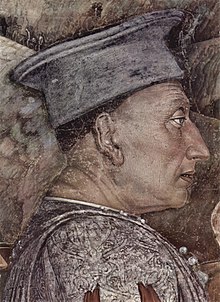Square academic cap: Difference between revisions
Mhardcastle (talk | contribs) →Tassel: tidy and provide reference |
|||
| Line 152: | Line 152: | ||
In the UK, the tassel is shorter and is gathered at the button at the center of the board. The U.S. style is slightly longer, gathered at a cord attached to the button. |
In the UK, the tassel is shorter and is gathered at the button at the center of the board. The U.S. style is slightly longer, gathered at a cord attached to the button. |
||
At |
At the University of Cambridge, undergraduates by ancient convention used to cut their tassels very short so that the tassel does not extend beyond the edge of the board. After they graduated, they wore the square cap with the tassel at the normal length<ref>Hoyle, Sir Fred, Home is where the wind blows, University Science books, 1994</ref>. This convention has now fallen into disuse; few people now wear headgear with academic dress at any time and undergraduates in particular have no need to wear the cap. |
||
== Traditional wear == |
== Traditional wear == |
||
Revision as of 15:49, 3 December 2011

The square academic cap, graduate cap, or mortarboard[1] (because of its similarity in appearance to the hawk used by bricklayers to hold mortar[2]) or Oxford cap, is an item of academic head dress consisting of a horizontal square board fixed upon a skull-cap, with a tassel attached to the center. In the UK and the US, it is commonly referred to informally in conjunction with an academic gown worn as a cap and gown. It is also often termed a square, trencher, or corner-cap in Australia. The adjective academical is also used.[3] In the US and UK, it is usually referred to more generically as a mortarboard, or (in the U.S.) simply cap.
The cap, together with the gown and (sometimes) a hood, now form the customary uniform of a university graduate, in many parts of the world, following a British model.
Origins

Origins of the most commonly found mortarboard in the United States can be traced to a patent that was filed by an inventor Edward O'Reilly and Catholic priest, Joseph Durham who filed their patent in 1950. Their invention and subsequent patent was the result of his idea to incorporate a metal filling into the mortarboard thus making it more sturdy. Such mortarboards are very commonplace throughout the world today.[4]
Variants

Doctorate-holders of some universities wear the mortarboard, although the round Tudor bonnet is more common in Britain. The 4, 6, or 8 cornered "tam" is gaining popularity in the US, and in general a soft square tam has some acceptance for women as a substitute for the hard 'square'.
In the US, the mortarboard is also worn by high school graduates during the presentation of their diplomas.
Tassel

In US graduation ceremonies, the side on which the tassel hangs can be important. Sometimes it is consistent among all students throughout the ceremony, in other cases it differs based on level of study with undergraduate students wearing the tassel on the right, and graduate student wearing them on the left. In some ceremonies, the student wears the tassel on one side until reception of the diploma, then it is switched to the other.
At the high school level, the tassel is usually either the school's primary color or a mix of the school's colors with as many as three colors in a tassel. Sometimes a tassel of a distinctive color, such as gold, is worn by those graduating with Latin Honors (e.g. cum laude) or on the "honor roll."
Universities in the United States might use tassels in black or the school's colors, usually for higher degrees.
For Bachelor degrees the tassel may be colored differently from the traditional black or school colors to represent the field (or one as closely related as possible) in which the wearer obtained his or her education. In 1896 most colleges and universities in the United States adopted a uniform code governing academic dress. The tassel may be adorned with a charm in the shape of the digits of the year.
However, strictly speaking, the American Council on Education (ACE) code states that "The tassel should be black or the color appropriate to the subject," and only makes an exception for the gold tassel. The gold metallic tassel is reserved for those entitled to wear the doctoral gown, as is the use of velvet for headwear. Only one tassel is worn at a time.
For schools where the graduation regalia is rented or borrowed by the student, the tassel might be a part of the rental or provided separately. Some schools that do not provide a tassel for graduates to keep may offer a souvenir tassel that is not worn with the regalia.
In the UK, the tassel is shorter and is gathered at the button at the center of the board. The U.S. style is slightly longer, gathered at a cord attached to the button.
At the University of Cambridge, undergraduates by ancient convention used to cut their tassels very short so that the tassel does not extend beyond the edge of the board. After they graduated, they wore the square cap with the tassel at the normal length[6]. This convention has now fallen into disuse; few people now wear headgear with academic dress at any time and undergraduates in particular have no need to wear the cap.
Traditional wear

As with other forms of headdress, academic caps are not generally worn indoors by men (other than by the Chancellor or other high officials), but are usually carried. In some graduation ceremonies caps have been dispensed with for men, being issued only to women, who do wear them indoors, or have been abandoned altogether. This has led to urban legends in a number of universities in the United Kingdom & Ireland which have as a common theme that idea that the wearing of the cap was abandoned in protest at the admission of women to the university. This story is told at the University of Cambridge, Durham University, the University of Bristol, the University of St Andrews, Queen's University, Belfast, Trinity College, Dublin and University College, Dublin among others.
There are several types of mortarboard that are usually made. The most common in the UK is the 'folding skull' in which the skull part can be folded for ease of storing and carrying. Traditionally, the mortarboard had a 'rigid skull' which is considered more aesthetically pleasing and better fitting than a folding-skull one. The rigid skull one is easier to doff with as the skull would not collapse in on itself, unlike a folding skull which naturally might, thus avoiding it being awkward when it is placed back on the head. Both types require the wearer to wear the appropriate size to fit. In the US, an 'elasticated skull' is mostly used which eliminates the need to make many mortarboards in different hat sizes. Some mortarboards, especially those in east Asia are laced-up at the back of the skull cap.
The correct way to wear a mortarboard is to have the larger part of the skull of the mortarboard at the back of the head with the top board parallel to the ground. A proper fitting mortarboard should not fall off easily.

Until the second half of the twentieth century, mortarboards were often worn by schoolteachers, and the hat remains an icon of the teaching profession.
Mortarboards are often seen in party supply shops in the United States in May and June, when they appear in the form of party decorations, on commemorative gifts such as teddy bears, and on congratulatory greeting cards.
Mourning cap
There is a version of the mortarboard that is worn during mourning. Instead of a tassel and button on top of the board there are two wide black ribbons that are attached from corner to corner of the board forming a cross. At the centre where the two ribbons intersect a black ribbon rosette is attached. The ribbon for the wide ribbons is grosgrain ribbon whilst the rosette can be made of either the same grosgrain or satin. This mourning cap can be worn when mourning a personal friend or a family relative.
Another version has nine ribbon bows called 'butterflies' attached to the back of the skull cap (three running vertically down the back seam, two vertically eitherside further towards the sides and one eitherside at the sides of the skull) in addition to the above. This cap is worn during the mourning of the monarch, a member of the royal family or the university chancellor.[7]
The mourning cap is worn with mourning bands (normal bands but with a pleat running down each band) and a mourning gown which is either a Cambridge DD undress gown with 'pudding-sleeves' but in black stuff rather than silk as worn in the sixteenth-seventeenth centuries or a plain black stuff gown. Hoods are not worn, as they are considered festal items. However, Cambridge proctors in the past wore their MA hoods squared, so as to conceal the lining; since the lining was white it did not clash with the black and white colour scheme of mourning.
Personalized doctoral cap

In some countries (e.g. Germany and Austria) it is tradition to prepare a personalized doctoral cap for the doctoral candidate and to hand it over in a ceremony short after the final exam (disputation). This tradition is prevalent among graduates in natural sciences (especially physics). The board of the cap is decorated with miniature objects reflecting the subject of the doctoral work. The preparation of the cap is usually carried out by candidate's colleagues and work group members.[citation needed]
See also
Notes
- ^ mortarboard. The American Heritage Dictionary of the English Language: Fourth Edition. 2000
- ^ Mortarboard. dictionary.com
- ^ [1] University of Cambridge Ordinances, Chapter II
- ^ US patent #2880423
- ^ The American Council on Education uses a brown/gray version of "Drab", not a green version or "Olive drab".
- ^ Hoyle, Sir Fred, Home is where the wind blows, University Science books, 1994
- ^ Hargreaves-Mawdsley, A History of Academical Dress in Europe Until the End of the Eighteenth Century (1963), p.137
References
- Goff, Philip (1999). University of London Academic Dress. London: University of London Press.
